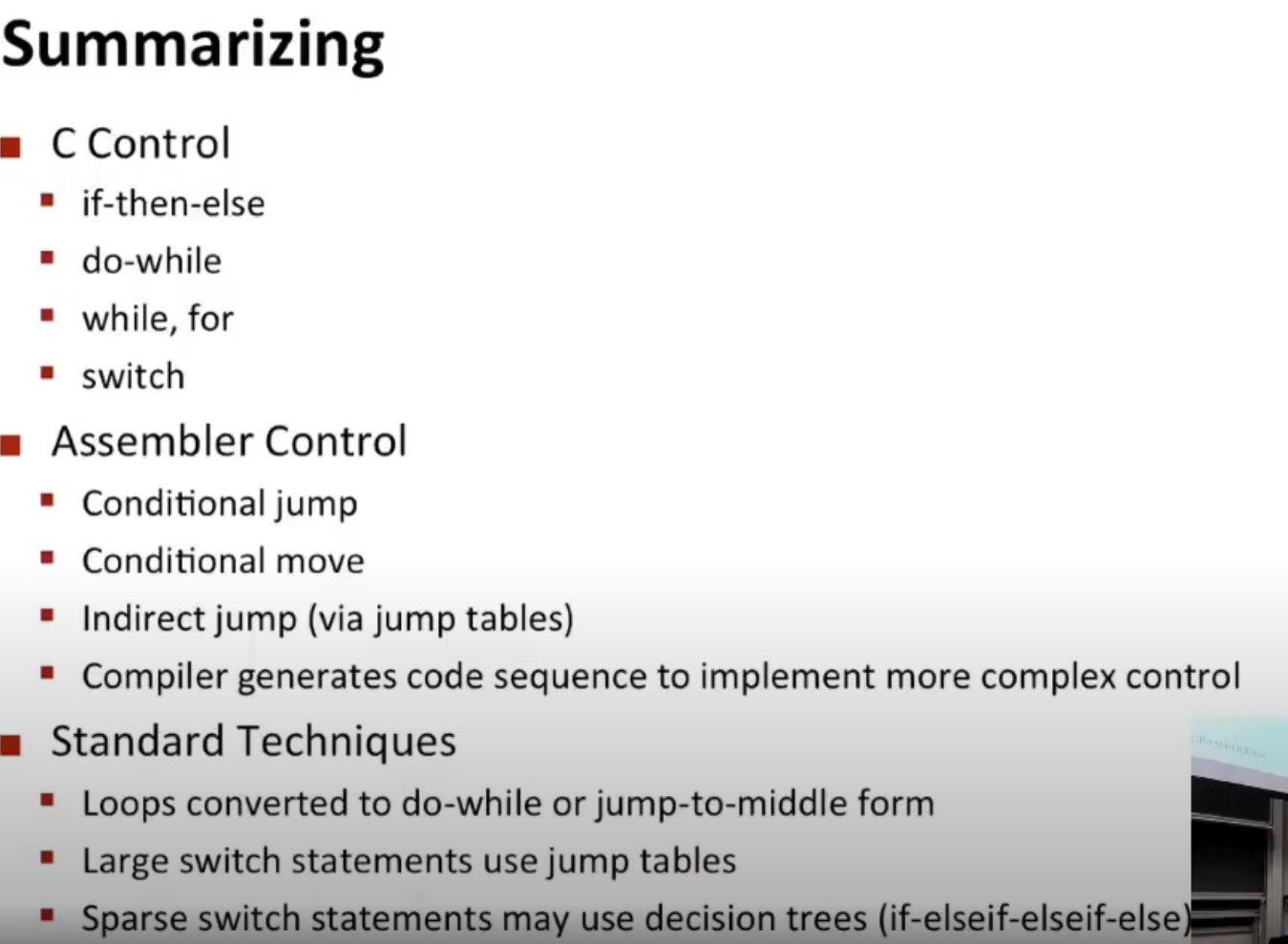6. Machine Level Programming - Control
Lec 6: Machine Level Programming: Control¶
This course uses Intel 64-bit version of the instruction set.
Outline¶
- Control: Condition codes
- Conditional branches
- Loops
- Switch Statements
Processor State (x86-64)¶
- Information about the current executing program
- Temp Data
(%rax, ...)
- Location of runtime stack
(%rsp)
- Location of current code control point
(%rip,...)
- Status of recent tests
(CF, ZF, SF, OF)
Conditional Codes¶
Actually, there are 8 in total. But today we only discuss 4 of them.
- CF: carry out from the most significant bit (unsigned overflow)
- ZF:
t==0 - SF:
t<0(as signed) - OF: two's complement (signed) overflow
- i.e.
(a > 0 && b > 0 && t < 0) || (a < 0 && b < 0 && t > 0)
They will be set by many instructions, but not including lea.
Usually, we use cmpq Src2, Src1 (src1 - src2) to compare two bins, testq Src2 Src1 (src1 & src2) to and one bin with another (usually when one src is a mask). These two instructions will not store data in anywhere, but set the corresponding control bits.
Read Condition Codes¶
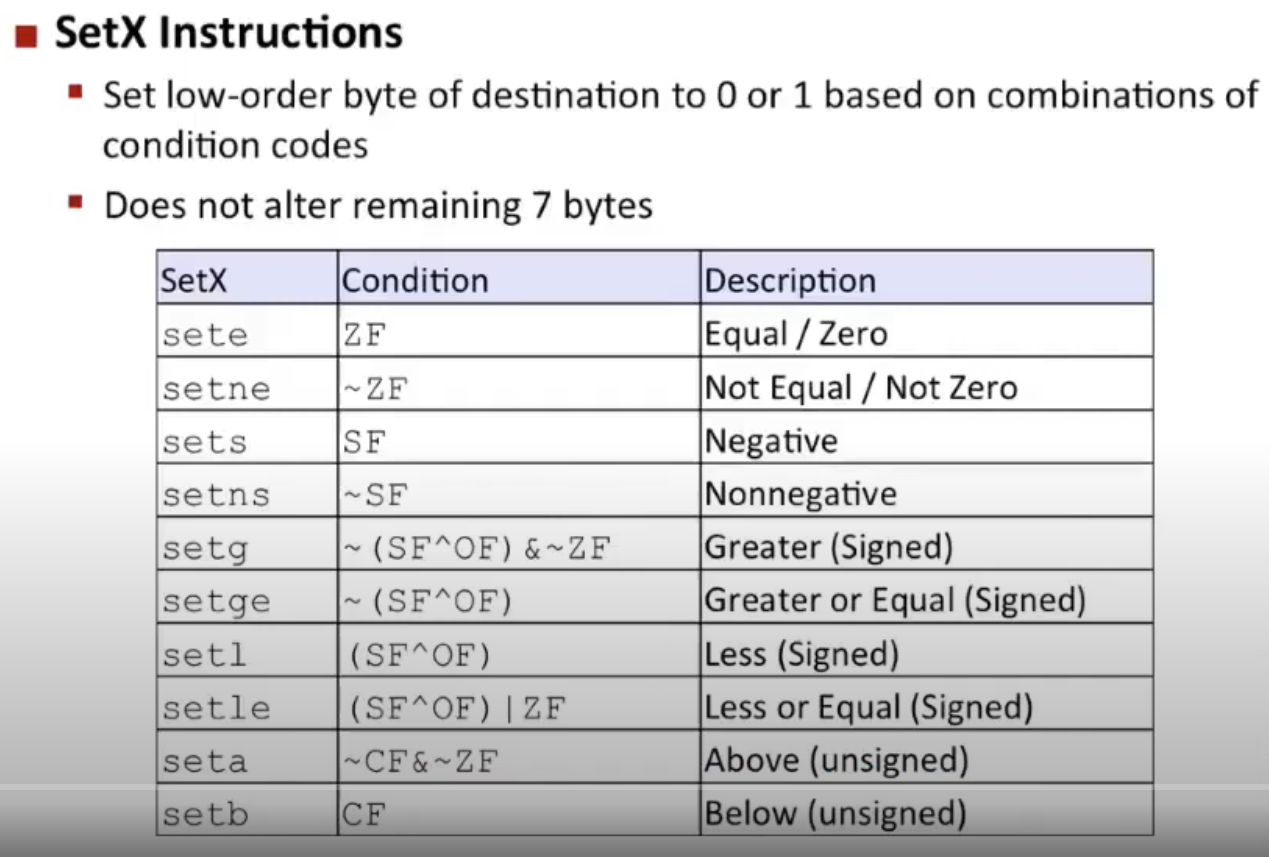
We can use set??? to set the lowest bit of a register according to some combination of condition code.
How to specify it? We won't use the normal register name anymore. Instead, we will use
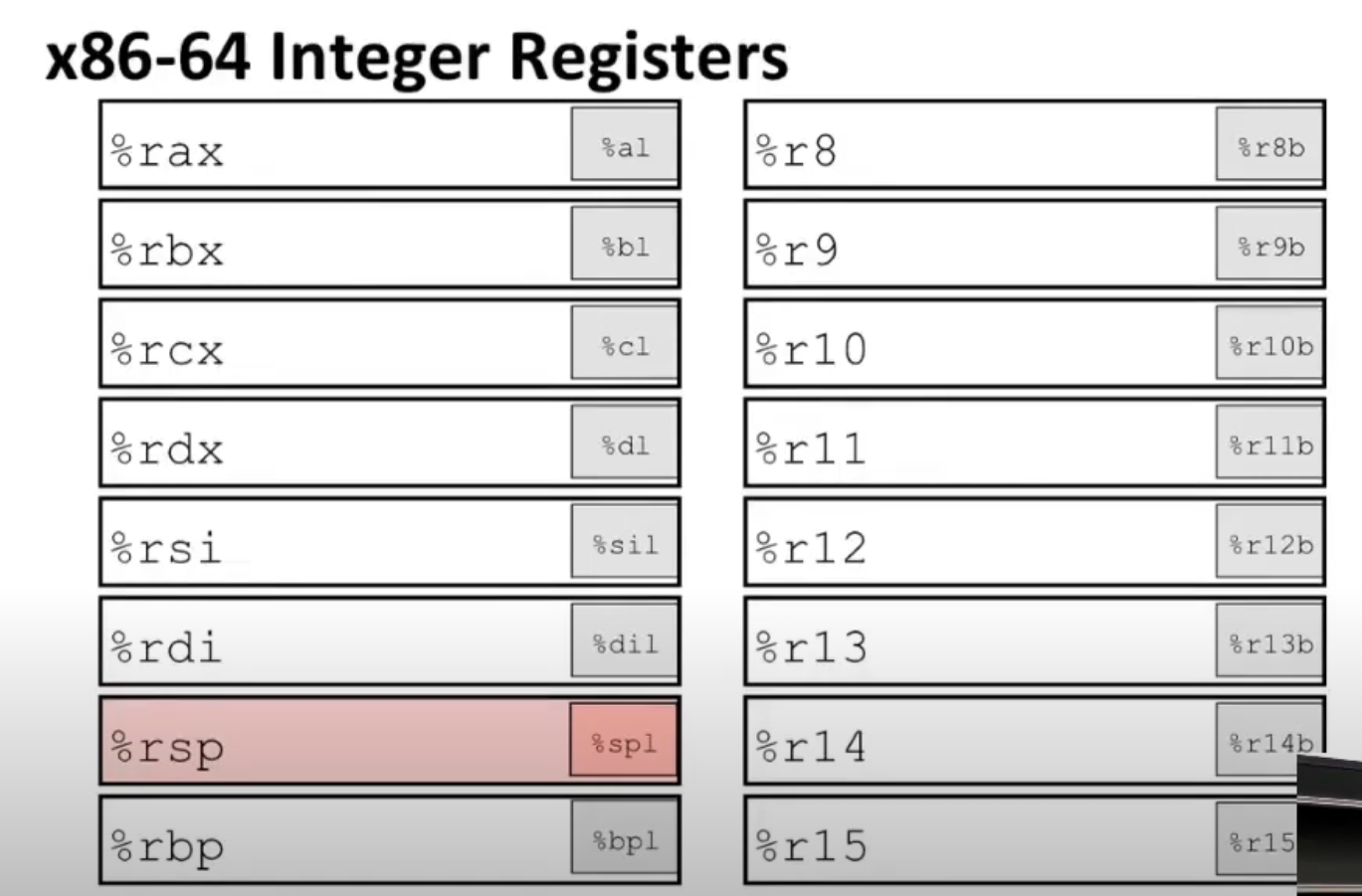
Example:
with
| Register | Use(s) |
|---|---|
%rdi |
Argument x |
%rsi |
Argument y |
%rax |
Return value |
greater_than:
cmpq %rsi, %rdi # compare x(dest) y(src)
setg %al # set %al if (x-y)>0, i.e. x > y
movabl %al, %rax # copy %al to the lowest byte of %rax, and set the rest bits of %rax to 0
rtn
Conditional Branches¶
Jumping¶
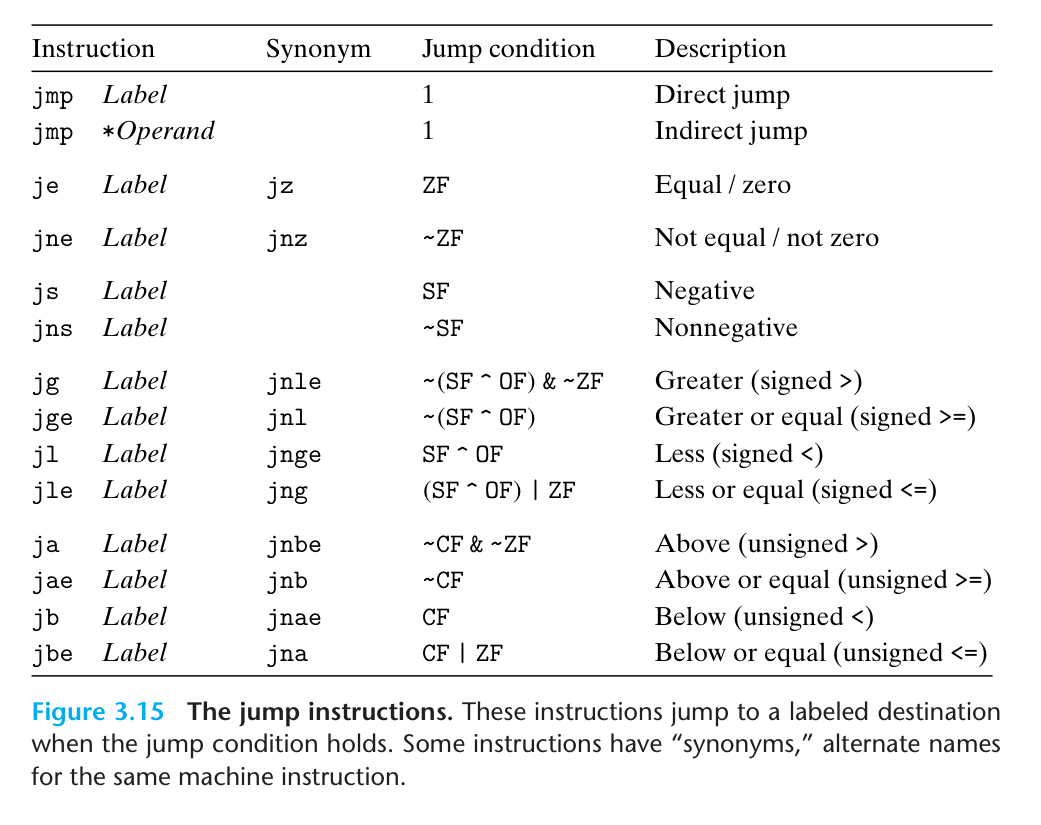
These are the instructions of all jmp's. And jmp really resembles goto in C/C++.
The following two pieces of code are of the same functionality, but the latter is more "assembly"-like.
long absdiff
(long x, long y)
{
long result;
if (x > y)
result = x - y;
else
result = y - x;
return result;
}
long absdiff
(long x, long y)
{
long result;
int ntest = x - y;
if (ntest < 0) goto Else;
goto Done;
Else:
result = y - x;
return result;
Done:
result = x - y;
return result;
}
/*
*/
absdiff:
cmpq %rsi, %rdi
jg .L1 # jump if %rdi is greater than %rsi
movq %rsi, %rax
subq %rdi, %rax
rtn
.L1:
movq %rdi, %rax
subq %rsi, %rax
# the first-move-then-arithmetic pattern is common in assembly
rtn
Conditional Move¶
Since modern CPU use pipelining technology, it's like a heavy tanker on a ocean - when going on a straight line, it will be really fast; but when doing side turns, it needs loads of time. So, we often don't like too much branching.
Thus, we can calculate two branches (and store them in two registers), and use "conditional move" to choose which one to take.
Note:
DON'T USE conditional move if
- computation is hard
- say
val = Test(x) ? Hard1(x) : Hard2(x) - computation is risky
- say
val = p ? *p : 0- i.e. if
p == 0,*pwill be invalid and thus unpredictable
- i.e. if
- computation has side effects
- say
val = x > 0 ? x *= 7 : x += 3
Loops¶
do-while loop¶
The most straight-forward way to implement loops in assembly is do-while-like loop:
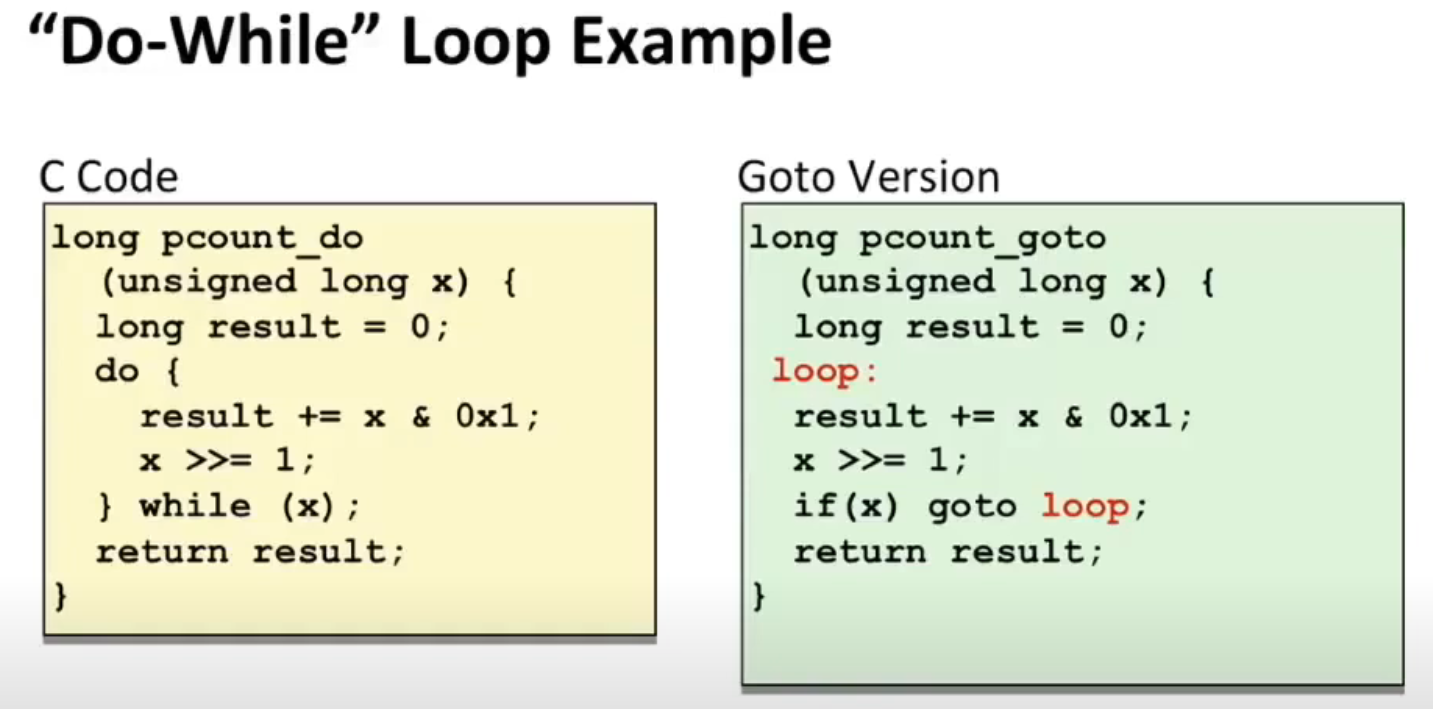
It's easy to see that replacing do-while with goto is straight-forward.
while loop¶
Also, you can implement while loop:
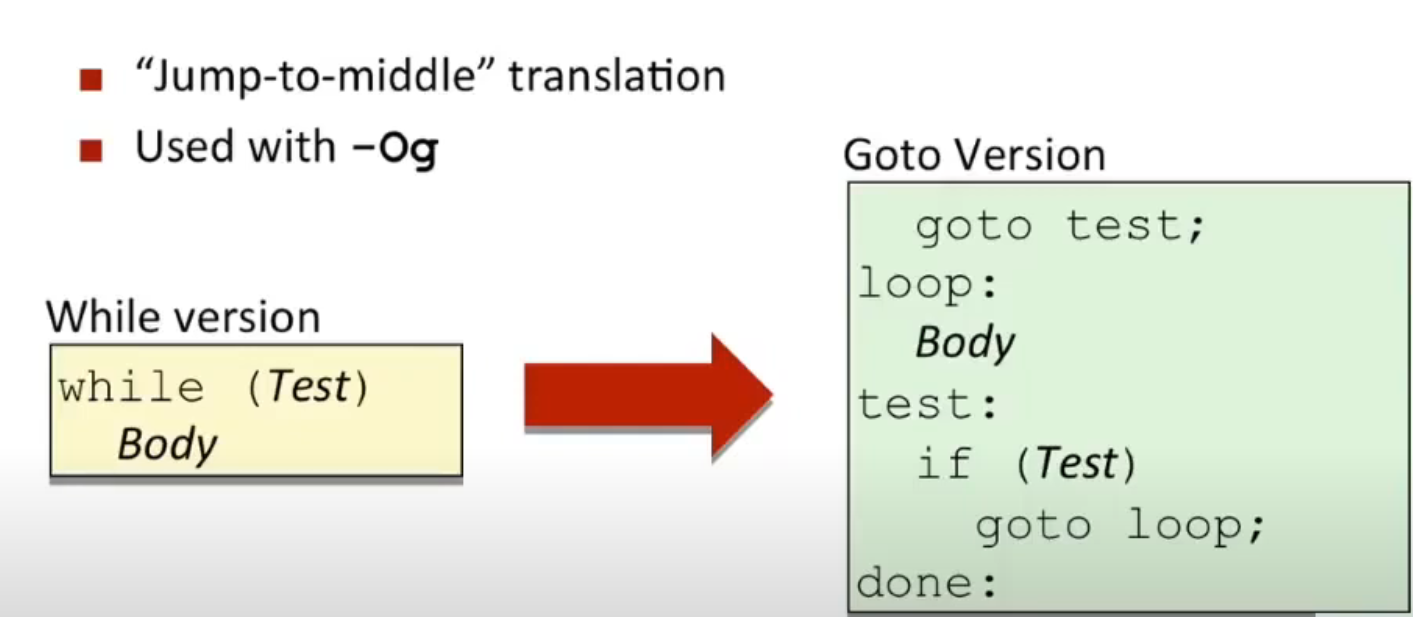
That is, if the initial condition is not satisfied, you will go directly to done.
Example (Modern Approach):
The C code below
long pcount_while
(unsigned long x) {
long result = 0;
while (x) {
result += x & 0x1;
x >>= 1;
}
return result;
}
is equivalent to the assembly-ish C code
long pcount_while
(unsigned long x) {
long result = 0;
goto test;
loop:
result += x & 0x1;
x >>= 1;
test:
if (x) goto loop;
// done:
return result;
}
And actually, there's another way of implementation (more traditional).
Example (Traditional Approach):
The C code below:
long pcount_while
(unsigned long x) {
long result = 0;
while (x) {
result += x & 0x1;
x >>= 1;
}
return result;
}
is equivalent to
long pcount_while
(unsigned long x) {
long result = 0;
if (!x) goto done;
do {
result += x & 0x1;
x >>= 1;
} while (x);
done:
return result;
}
Thus,
long pcount_while
(unsigned long x) {
long result = 0;
if (!x) goto done;
loop:
result += x & 0x1;
x >>= 1;
if (x) goto loop;
done:
return result;
}
for loop¶
The structure of for-loop:
We can convert it into while-loop:
##define WSIZE 8*sizeof(int)
long pcount_for
(unsigned long x) {
long result = 0;
for (i = 0; i != WSIZE; ++i) {
unsigned bit =
(x >> i) & 0x1;
result += bit;
}
return result;
}
Here,
-
initisi=0 -
testisi != WSIZE -
updateis++i -
bodyis
Thus:
##define WSIZE 8*sizeof(int)
long pcount_for
(unsigned long x) {
long result = 0;
int i = 0;
goto test;
loop:
unsigned bit =
(x >> i) & 0x1;
result += bit;
// update
++i;
test:
if (i != WSIZE) goto loop;
return result;
}
switch statements¶
switch statement is one of the most poorly designed statement in C (and this bad feature also passed down to Java, etc.). There is a rule of thumb that help you stay away from bugs:
- If you want a
caseto fall through, add comment -/* fall through */
Jump Table Structure¶
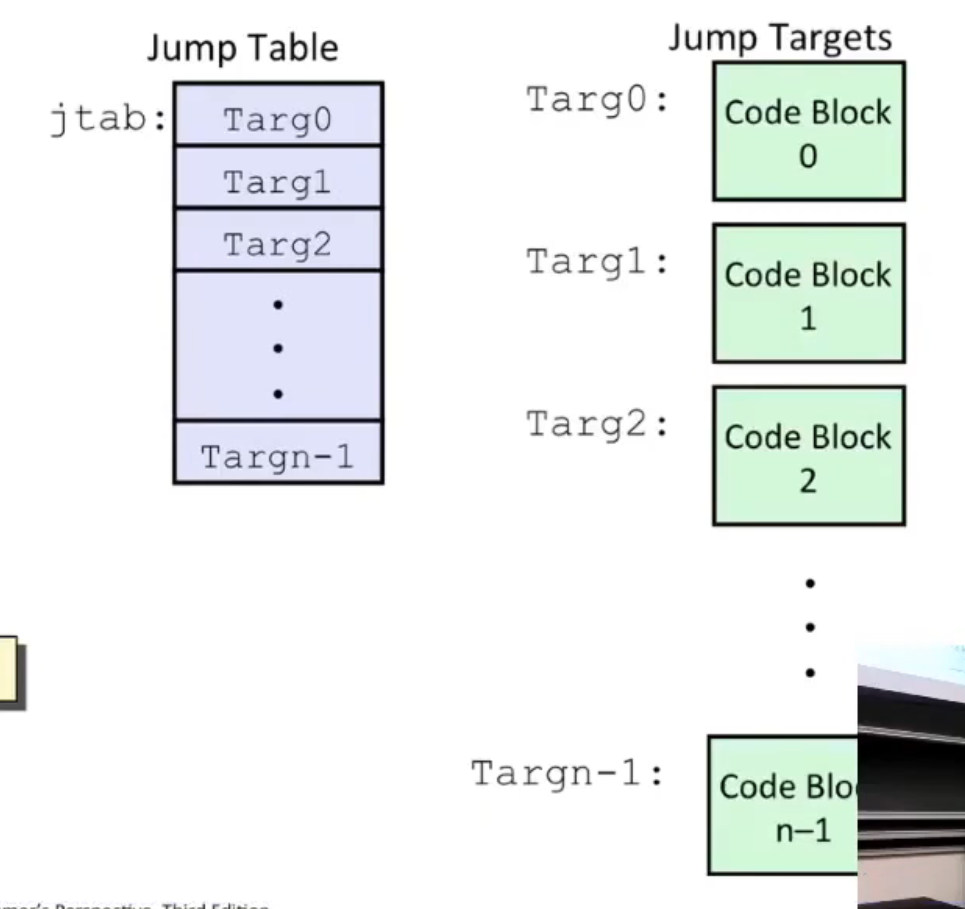
Example:
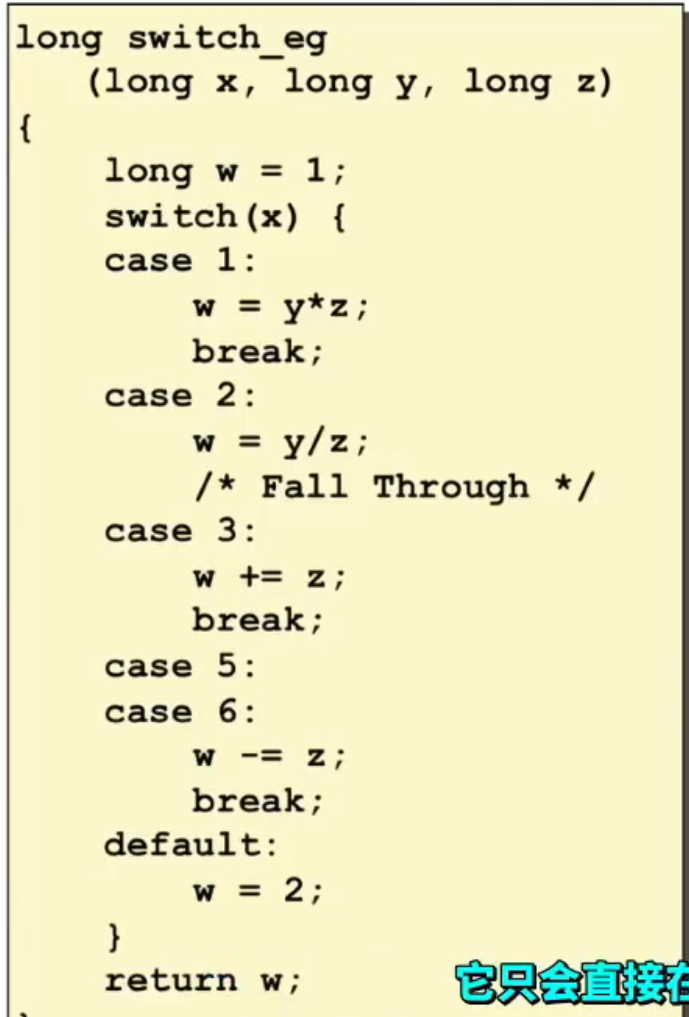
Setup
switch_eg:
movq %rdx, %rcx
cmpq $6, %rdi # whether x is in range [0,6]
ja .L8 # if not, go straight to default branch
jmp *.L4(, %rdi, 8) # if so, go to jump table
# *.L4(, %rdi, 8) := *JTab[x], where `JTab` is of type `long []`
Jump Table
.section .rodata
.align 8
.L4:
.quad .L8 # x = 0 # 0 is not in `case`, so default
.quad .L3 # x = 1
.quad .L5 # x = 2
.quad .L9 # x = 3
.quad .L8 # x = 4 # 4 is not in `case`, so default
.quad .L7 # x = 5 # 5 and 6 share the same piece of code
.quad .L7 # x = 6
Note:
- if the cases are "dense" (and the range is large), the assembler will use jump table, which is \(\mathcal O(1)\)
- and if there is negative number, the assembler will add bias to
w, so that all are positive. - if the cases are "sparse" (or the range is very small), say
case 0: //... case 114514: // ..., the assembler will merely useif-else - but with binary-tree-like conditional jump! So the time complexity is \(\mathcal O(\log(N))\).
-
Why can it do this? Well, the
caseoperands areconstexprs, so gcc can sort them in advance and implement the bst. -
So, in either case, the assembler does much better job than naive
if-else.
Summary¶
The four major assembler controls are the basic primitives of almost all changes of flow execution, etc in a program.
